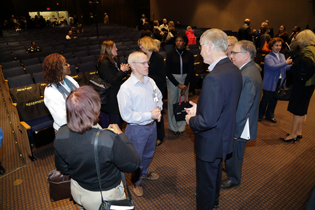The Shutdown
Its Impact on Extramural and Intramural
On October 23, 2013, NIH Director Francis Collins held an hour-long town hall meeting in which he condemned the effects of an “unnecessary and ultimately pointless shutdown” that closed the government October 1–16 and idled 75 percent of the NIH workforce. He outlined a steadily deteriorating political landscape that included multiple threats of shutdown, then the reality of budget sequestration, culminating in a 16-day shutdown coinciding with the start of FY2014. Federal regulations barred any but “excepted” employees—those with responsibility for the preservation of life (human and animal) and property—from coming to work. Collins also answered questions submitted by the audience and via e-mail.

ERNIE BRANSON
On October 23, 2013, NIH Director Francis Collins hosted a Town Hall Meeting on the effects of the government shutdown on NIH.
There was, however, a silver lining to the shutdown debacle, Collins said. “NIH was mentioned over and over again” in the media as a national treasure worth preserving; several members of Congress even introduced bills to reopen NIH during the shutdown.
Looking to the new year, Collins noted “the only certainty these days is uncertainty,” but held out hope that congressional budget negotiators can reach a solution that includes the abolition of sequestration.
Collins said he was inspired by “the enthusiasm and commitment” of an NIH workforce that returned on October 17. He enumerated triumphs including a decision not to ditch the October grant-submission cycle. Even though more than 200 peer-review meetings were scuttled by the shutdown, affecting some 11,000 grants, NIH will work double-time so as not to delay this process for another four months.
Collins concluded, “I am humbled and thankful to be associated with all of you … your professionalism is a delight to behold.”
A videocast of the town hall meeting may be viewed (by NIHers only) at http://videocast.nih.gov/launch.asp?18126.
Impact on Intramural Program

ERNIE BRANSON
NIH Director Francis Collins greets attendees after the October 23 Town Hall Meeting.
The furlough of three-quarters of NIH’s workforce for 16 days dealt a particularly hard blow to the Intramural Research Program, putting 2,500 research protocols and 1,500 clinical protocols on hold, said NIH Deputy Director for Intramural Research Michael Gottesman.
“Suddenly coming to a complete halt—that’s a big blow to the whole research establishment,” he said. Many experiments were lost and will have to be repeated, he said, anticipating that it will take a few weeks for most research projects to get back up to speed.
Troubling to Gottesman was the message a furlough sends to the wider research community. “NIH has compacts with all sorts of organizations. Our scientists collaborate, give talks—all part of our official duties—and suddenly we were not reliably there to do that. All of a sudden, NIH looks like a less reliable partner.”
Although the Clinical Center remained open, only 75 percent of its staff was on hand, he said, and attendance varied from institute to institute, based on the clinical studies under way. Of seven protocols due to begin during the shutdown, only one was allowed to go forward, based on its potentially life-saving effect. And only 25 of more than 400 scheduled patient visits were permitted during the shutdown.
“No one could be in a lab without a supervisor,” Gottesman said. Not all lab chiefs, nor all scientific directors, hold “excepted” positions, he noted. Those who were permitted to work found themselves handling such routine duties as checking freezers and animal colonies.
The definition of “excepted” is not the same for a furlough as it is for a campus emergency, Gottesman explained.
“We were very careful with our animal [colonies],” Gottesman continued, allowing continued breeding and ensuring that animals were genotyped to preserve needed cage space. “We won’t have to start from scratch with our animals.”
On any given day, NIH as a whole manages around 384,000 animals, including more than 330,000 mice, said Terri Clark, director of the Office of Animal Care and Use. There had been concerns that a prolonged shutdown would have led to a need to euthanize many mice due to overcrowding. But that did not happen, she said. A small number were culled and euthanized in the normal course of breeding operations that occurred during the shutdown.
“We came out of this in relatively good shape in that we didn’t need to euthanize a lot of animals due to the cessation of experiments—it was a very, very small number. The larger focus is the loss of research time,” said Clark. Only critical animal studies already in midstream or experiments of particularly high value, as determined by the scientific directors, were allowed to go forward.
“We all breathed a deep sigh of relief that it didn’t go longer,” said Clark.
Gottesman was reluctant to name heroes during the shutdown. “There are more than I could enumerate,” he said. “Everyone who was here was doing the job of many others. It’s hard to single out individuals. Even those who did what they were supposed to do by staying home did their part.
“What was amazing to me, though, was that as soon as people came back, spirits lifted enormously.”
This article was adapted with permission from one that appeared in the November 8, 2013, issue of the NIH Record. To read more of Gottesman’s thoughts on recovering from the shutdown, see his essay.
This page was last updated on Thursday, April 28, 2022
